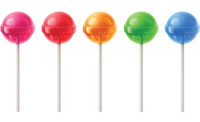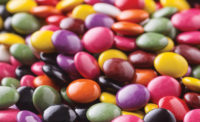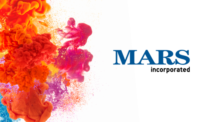
Photo courtesy of Chr. Hansen.
By Grace Weitz
The colors of the food rainbow have long been Allura Red, Ponceau 4R, Tartrazine, Sunset Yellow FCT/Orange Yellow, Quinoline Yellow, and Carmoisine. But with synthetic colors practically eradicated overseas, all those hues are turning a shade purer.
Natural colors - colors derived from natural sources such as vegetables, fruits or minerals - seemed to thrive in 2009, with the global food color market boasting a 2.1% growth and worth an estimated $1.45 billion, reports Leatherhead Food Research.
In the United States alone that year, new product launches with natural colors accounted for 3.7% of the confectionery market, states Innova Market Insights. That dropped to 2.2% in 2010, but companies still are latching onto this sector because of the recent changes in the European market. Europe’s artificial color sector began to disappear after the 2007 Southampton Study linked synthetic colors to a potential increase in hyperactivity in kids.
Since then, the European Union has enforced stricter labeling laws. Effective July 2010, all companies are required to post a warning sign on products that contain any of “The Southampton Six” - Alurra Red (aka Red 40), Ponceau 4R (E124), Tartrazine (Yellow 5) (E102), Sunset Yelllow FCT/Orange Yellow (Yellow 6) (E110), Quinoline Yellow (E104) and Carmoisine (E102).
In the United States, the Food Drug Administration (FDA) hasn’t had quite the same reaction as the European Food Safety Authority (EFSA). Campbell Barnum, the v.p. of branding and market development at D.D. Williamson, a global natural color manufacturer, says that conclusions from the Southampton study are debatable from a scientific perspective, which is why the FDA hasn’t been as eager to react.
Jason Armao, the applications project manager at D. D. Williamson notes that, although there hasn’t been a full switch to natural colors like in Europe, companies are preparing in case the FDA goes down the same avenue in the future.
Another factor is that many European-based companies in the United States are global, says Dina Dix, a senior scientist in colors for Chr. Hansen, a worldwide ingredient technology manufacturer.
“If you have a customer in the United States or in England you want to be able to sell the same Butterfinger bar [for example], but you can’t sell artificial colors in England, so you’ve got to change it for everybody,” says Joni Stern, president of Stern Ingredients, an industrial ingredient broker for the confectionery industry.
Stern cites that fact as one of many reasons why 90% of her customers are no longer working with FD&C colors.
Keeping the label clean
Awareness also has fueled the natural color market, with more consumers likely to read the ingredients statement. Simply put, “[Natural colors] give a cleaner label,” says Dix.
Although the FDA prevents companies from actually including the word “natural” on the back of their products, David Dukes, president of International Foodcraft Corp., thinks that “people know enough to know that FD&C means artificial and vegetable juice is vegetable, so they just feel better about that, where as they see FD&C and they think chemical.”
Barnum points out also that with the Web, and all the information out there, people are more informed and turning to products with naturally derived colors as opposed to artificial ones.
“The synthetic colors for the most part in the U.S. are labeled as FD&C colors and that may give a consumer a negative perception about the product,” says Armao “It may not, but it just depends on the level of knowledge that the consumer has or their interest in a healthy diet.”
On the nutritional front, Stern says “the jury is still out on whether [natural colors] are healthier.” Dix notes, however, several different natural colors that have possible health benefits.
Anthocyanins, which are used for shades of red at a higher pH and blue at a lower pH, and can come from either vegetables or fruit, contain a plant-derived nutrient called phytonutrients - powerful antioxidants that can strengthen the immune system and possibly deter cancer.
Turmeric, which provides a natural yellow color, also has been shown to have anti-inflammatory effects, says Dix. Unfortunately, natural colors have several downsides from their synthetic counterparts.
“The big thing for everyone is the fact that natural colors aren’t as vibrant and they don’t have the shelf life,” says Dukes. “The thing you have to understand with natural colors is some are temperature dependent, some are affected by light and others are affected by pH.”
Because naturally derived colors tend to blanch or cloud more quickly, their shelf-life can be shortened and their stability affected. Dukes explains that there are even avenues impossible for natural colors to cover.
For example, there just does not exist an FDA-approved natural colorant that will give a good blue or green color at a low pH. IFC (whose natural color sales increased 400% last year, according to Dukes) has delved into this arena, with the manufacturing of their Coloreze line - natural blacks, blues, greens and purples that are available for waterand fat-based products.
“We have a phenomenal black,” says Dukes.
Armao agrees that certain shades have challenges with being naturally replicated - an important issue because color has a lot to do with a product’s success on the market and companies don’t necessarily want to mess with an already established brand, says Armao. Cost can be another factor, notes Dix.
“[Natural colors] are grown. They’re actually a cultivated product,” says Dix “They have a lot more handling... to somebody who has to cultivate it and gather it...[followed by] the color extraction or expression ,depending on what the product is.”
As a result, natural colors can be affected by the fluctuating supply or pricing of a certain ingredient. Solutions are hard to come by because so many factors such as storage and display conditions, product composition and processing techniques come into play, but companies are attempting to overcome these deficiencies with several different products.
Chr. Hansen is known best for their ColorFruit brand, a line of blended anthocyanins that produce a more stable natural color. Another product unique to the company is CapColors, which takes water in soluble pigments, such as annatto and turmeric. Then, through processing, the company renders the ingredients dispersible in a water-based matrix of food. The technique increases overall stability in applications including light and heat.
In 2009, WILD Flavors, Inc introduced a naturally derived, acid-stable blue color as a part of their Colors From Nature line.
The product was the first in the United States to achieve a natural blue color over an acid-stable pH range of 2.5-8.0 by deriving the color from fruit as opposed to red cabbage or other anthocyanin base colors.
Growth continues
Despite obstacles, the market has managed to refine itself, says Dukes.
“Because natural colors are becoming more mainstream people are getting better at making them,” explains Dukes. “We’ve learned tricks over the years to make natural colors last longer, and be brighter by blending different ones together.”
Barnum agrees, saying that in the end, even with possible challenges, manufacturers are continuing to develop new products with natural colors.
“We see [natural colors] as a small, but growing niche,” says Barnum. “Our customers and candy manufactures are increasingly choosing natural colors over synthetic despite those issues.”






